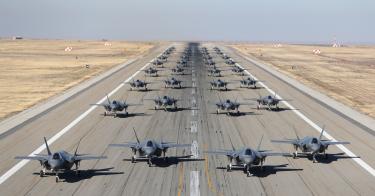Even amid the global COVID-19 crisis, the Chinese Communist Party continues its military aggressiveness on the international stage.
This can be seen in its military activities in waters disputed with Malaysia and Vietnam, around territory controlled by the Philippines, and its threating posture toward Taiwan. The increased use of force to bully others reflects Beijing’s growing sense of power, undergirded by decades of consistently larger defense budgets.
Recognizing these concerning trends, Congress last year asked Admiral Phil Davidson, the military’s Indo-Pacific theater commander, to submit a plan outlining options to enhance deterrence in the region. The plan, carrying the moniker “Regain the Advantage,” proposes five years of investment totaling $20 billion to be applied toward defending American interests in the Indo-Pacific, the region the Defense Department has identified as its priority theater.
More than half of the $20 billion would be spent on increasing the lethality of the military assets in the region, such as homeland defense radars and long-range precision fires, and to improve force posture by means such as building better in-region training facilities and installations to bed-down a more forward-stationed fighter squadron and other forces.
Another quarter of the spending would go toward improving logistics and security posture, such as dispersing fuel and ammunition stocks. Taken as a whole, the proposal represents some very practical and useful ideas for improving U.S. deterrence in the Indo-Pacific and putting our forces there in a better posture for warfighting, should it come to that.
Congress is now beginning to seriously consider ways to increase the funding dedicated to the Indo-Pacific region. On the House side, Armed Services Committee Chairman Adam Smith (D-Wash) supports the idea of enhancing deterrence in the Indo-Pacific. Ranking Member Mac Thornberry (R-Texas) has gone a step further, releasing a detailed plan that takes Davidson’s plan and ups the ante, increasing funding in the first year.
On the Senate side, Armed Services Committee Chairman Jim Inhofe (R-Okla.) has come out strongly in support of Davidson’s plan. “The reality is that the military balance in the Indo-Pacific is getting worse,” he noted. “This [Davidson’s] assessment provides critical information for understanding how to reverse this trend and to protect American interests in this important region.”
This emerging bicameral and bipartisan support for strengthening U.S. military presence in the Indo-Pacific bodes well for American efforts to preserve the peace in the region.
But the proposals also highlight a persistent challenge in deciphering the U.S. defense budget: It is extremely difficult to identify the total funding committed to specific efforts like defense of the Indo-Pacific or cybersecurity because it is dispersed among thousands of separate budget lines spread throughout the department. Depending on which analyst you ask and where that person sits, you will never get the same answer.
The effort to enhance American military deterrence in the Indo-Pacific needs to be accompanied by an effort to create better systems to help lawmakers and analysts understand how much is really being dedicated to the task in the first place. This should not be a question of what percentage of an F-35 at Hill Air Force base is dedicated to the theater, but rather of what the discreet Defense Department programs are that support the mission in the Indo-Pacific.
There is no question that the United States needs to be more engaged in the Indo-Pacific. The National Security Strategy, the National Defense Strategy and the Indo-Pacific Strategy all point in the same direction: We must meet the increasing challenges to international rules and norms posed by the People’s Republic of China.
The driving question is how to operationalize it. The Indo-Pacific Deterrence Initiative would provide a focal point for the efforts in the region. Further, the Initiative would allow Congress, the Department of Defense and, most importantly, the American people to get a better sense of what we are doing in the region and what else we can and should be doing.
This piece originally appeared in The Hill on 5/22/20



